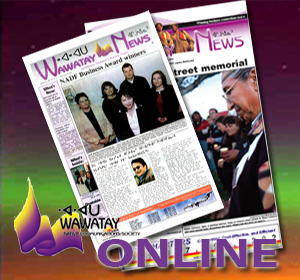Travelling in the north has always been a hazard for all kinds of reasons. The remoteness makes it difficult to have all the latest technologies in place. It is not like life in the south where many safety precautions are in place for the every day traveller no matter what their means of transport. The weather is a risk factor in the north most of the year but in the winter time things can actually be deadly.
Most northerners from remote First Nations were saddened but not surprised to hear about the recent aircraft accident that occurred in North Spirit Lake First Nation in northwestern Ontario January 10. The accident involved a Keystone Air passenger plane, which crashed a kilometre short of the community’s runway during a blinding snowstorm. Four people died in the crash and one person survived.
The community leaders have pointed out that navigational aids for landing aircraft are not available at their airport. That creates problems for landings in poor weather. The lack of the latest safety equipment contributed to this tragic accident.
The news of this plane crash in a remote northern community brought back memories of fearful flights during the winter back home in Attawapiskat. We did a lot of flying around when I was a teenager attending high school in southern communities like Timmins and North Bay. My friends and I regularly flew up north and down south again for every major holiday during the school year. The flights arriving home for Christmas and the ones leaving after the New Year were always the scariest. To make matters worse we had to take off and land several times on one journey. On a trip from Timmins to Attawapiskat we had to land and take off in Moosonee, Fort Albany, Kashechewan and then finally arrive home.
I recall taking off from Timmins at night in near blizzard conditions and landing at each community with blinding snow all around us. I always had an appreciation of the on board aircraft technology, navigational aids and the pilot’s skill needed to fly a plane in the wintertime. Even when I was young I also understood that our safety depended on some luck. I remember watching the lights outside my passenger window and wondering how anyone could see through the blizzard of white specks and the darkness beyond. There were times during some flights when the pilot just couldn’t land our plane safely with the first approach and had to take off, circle the airport and try again. It was frightening to be tossed about in an enclosed cabin, up and down, then left and right, without knowing if we were going to survive the flight. I was always relieved to hear that loud thud of the wheels hitting the frozen gravel runway and then the whine of the engines as we braked.
Anyone that lives in a remote First Nation community has stories like mine. Even if people never flew they were always aware of the comings and goings of aircraft. My dad and my brothers handled a cargo business in Attawapiskat and our work regularly took us to the airport to unload the freight service. It was a common occurrence in the wintertime during blinding snow storms to listen to the aircraft circling the community. We could hear the plane just over our heads and understood that the pilot was waiting for a short window of opportunity to line up and possibly land. I recall watching some cargo flights that had no passengers, dip down from under the clouds, bank steeply left and right over the treetops to line up for the runway and at the last second straighten out for a quick landing. It’s a scary sight to see the flood lights of a plane appear out of the clouds, bobbing in all kinds of directions before finally finding the runway.
Community leaders in many northern First Nations understand what is needed to make these flights safer but in too many cases, their requests are put off or forgotten. Chief Rita Thompson, of North Spirit Lake FN explained in news reports after the accident that her First Nation has been asking for airplane approach sensors for more than a decade.
Flying aircraft in the north is a challenge and doing so during the wintertime is an even greater risk. We shouldn’t have to wait for a tragedy to occur like the one in North Spirit Lake to take notice of these risks. Many northern remote communities across Canada rely on air service as a lifeline to the rest of the world.
Our leadership and those responsible for providing services and funding for remote northern First Nation airports should really make a point to provide airplane approach sensors and any other vital technology for communities that don’t have the latest aids. This will save lives.
If you pause to think about it, there are special people in our lives that we always assumed would always be around no matter where our life journe








If you pause to think about it, there are special people in our lives that we always assumed would always be around no matter where our life journey takes...
There have been so many changes over the past couple of decades for Indigenous First Nations and I am amazed at how life has changed for many people. Most...